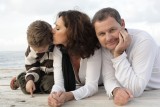Read this ebook for free! No credit card needed, absolutely nothing to pay.
Words: 25806 in 19 pages
This is an ebook sharing website. You can read the uploaded ebooks for free here. No credit cards needed, nothing to pay. If you want to own a digital copy of the ebook, or want to read offline with your favorite ebook-reader, then you can choose to buy and download the ebook.
Lesson Credit Page Number Title Points Number How to Use This Book 1 B-1 Getting Acquainted With Electricity 3 2 B-2 Tools for Electricians 4 7 B-3 Rewire a Lamp--Be a Lamp Detective 3 11 B-4 Make a Trouble Light 3 15 B-5 What Makes Motors Run 5 18 B-6 Taking Care of Electric Motors 3 23 B-7 Reading the Electric Meter 4 26 B-8 Ironing is Fun 3 30 B-9 Let's Be Friends With Electricity 2 35 B-10 How Electric Bells Work--For You 3 39 B-11 First Aid for Electrical Injuries 2 43 B-12 How Electricity Heats 3 47 B-13 Mysterious Magnetism 2 50 B-14 Give Your Appliances and Lights a Square Meal 2 54 B-15 You Can Measure Electricity 4 58
UNIVERSITY OF IDAHO COLLEGE OF AGRICULTURE AGRICULTURAL EXTENSION SERVICE Eric B. Wilson, Extension Agricultural Engineer 1962
Published and distributed in furtherance of the Acts of May 8 and June 30, 1914, by the University of Idaho Extension Service, James E. Kraus, Director; and the U. S. Department of Agriculture, Co-operating.
LESSON NO. B-l
Credit Points 3
GETTING ACQUAINTED WITH ELECTRICITY
Electricity serves you best when you understand how it works and use it properly. As a 4-H member, you should know about electricity and help to show others the way to obtain its tremendous work-saving benefits as well as how to use it with safety.
A good way to think of electricity is to compare it with water. It acts a lot like water. However it is made of tiny parts of atoms called electrons. When there are more than the normal number of electrons in anything, it is said to be negatively charged; when there is a shortage of electrons, it is positively charged. As water flows downhill, "seeking it's level," electrons flow from negative to positive, seeking to "balance" the charge.
Electrical Conductors
Even if you're never going to repair a lamp or make a chick brooder, you should know about conductors and insulators. This is because you happen to be a fairly good conductor of electricity. Electricity will pass easily through you to other conductors--the ground, for instance. When this happens you may get a shock, burn, or serious injury. But it doesn't ever have to happen, if you learn to understand your friend, electricity.
Silver, copper, iron, aluminum and many other metals are very good conductors. Water, acids, and salts are too. Electricity passes over or through them very easily. Like water pipes, the larger the conductor, the more electricity it can carry. When conductors are too small for the amount of electrons trying to move over them, they get hot, melt, may start fires. That's why wire size is important.
Electrical Insulators
Free books android app tbrJar TBR JAR Read Free books online gutenberg
More posts by @FreeBooks

: Dwarf Fruit Trees Their propagation pruning and general management adapted to the United States and Canada by Waugh F A Frank Albert - Fruit-culture


: Memoirs of an American Prima Donna by Kellogg Clara Louise - Singers United States Biography; Kellogg Clara Louise 1842-1916








